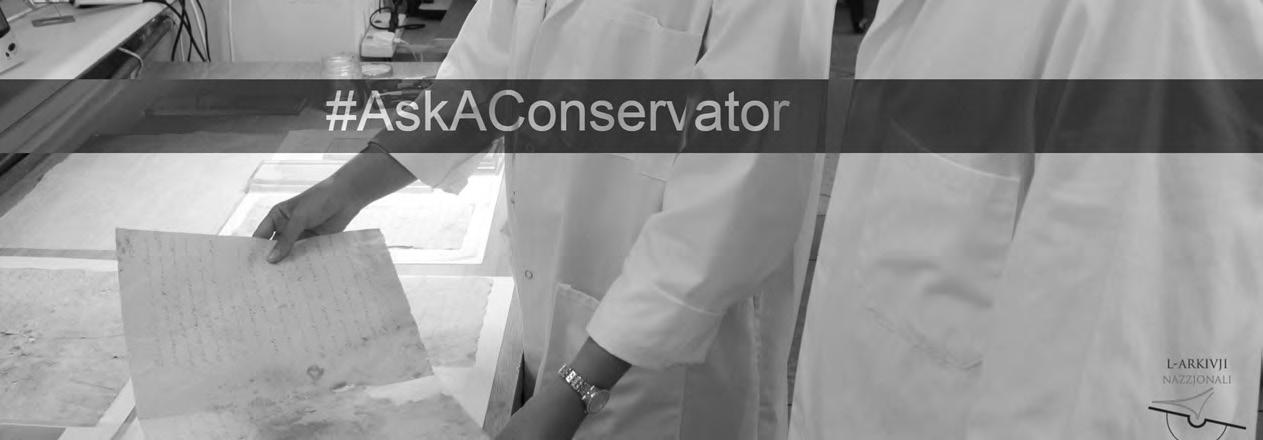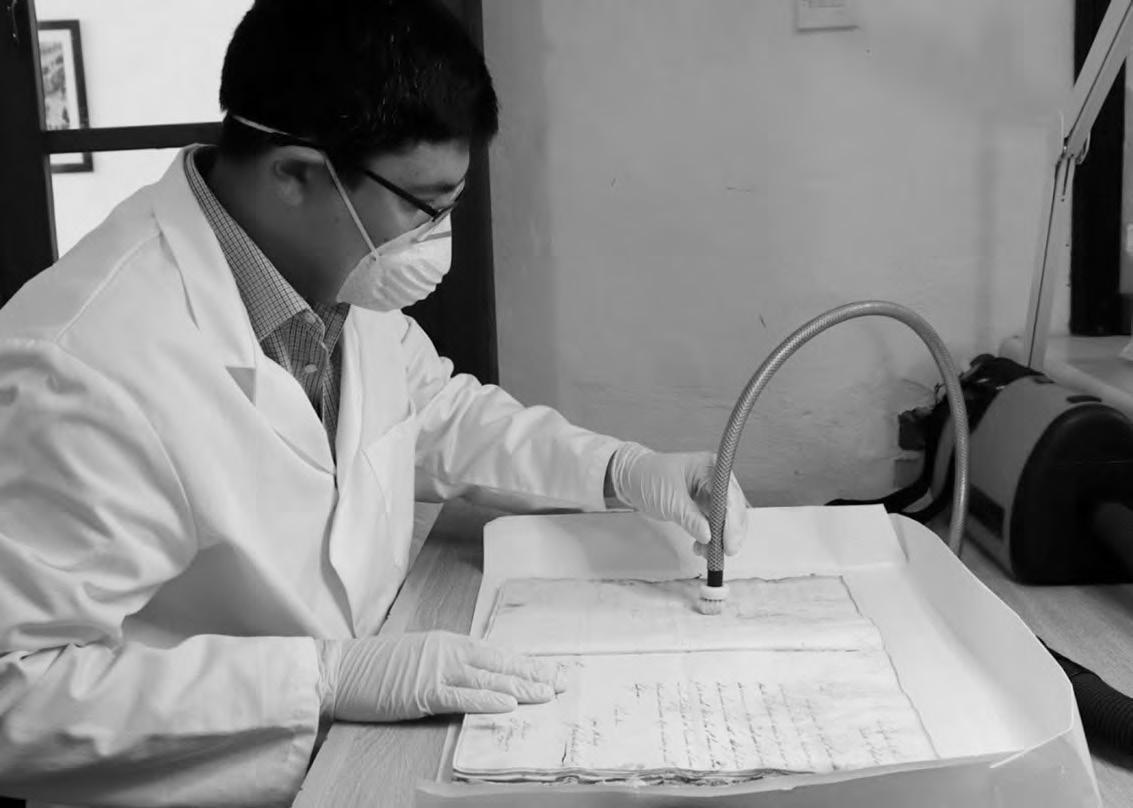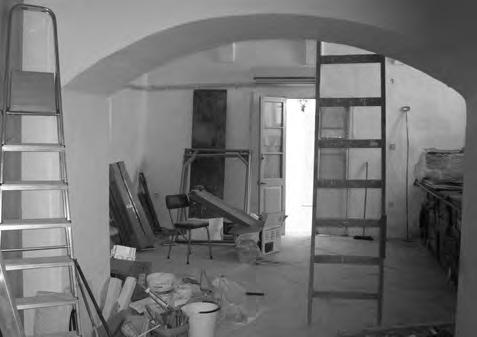
10 minute read
4 Conservation Laboratory Work
Conservation of the designs of church paraments by GF Vassallo of Cospicua, designed in 1930 and commissioned for the altar of the Rosary at Luqa parish church (see also page 34).
4 CONSERVATION LABORATORY WORK REPORT 2020
Advertisement
The year 2020 ushered it several changes. The major of these was an increase and change in personnel. Sarah Portelli a new Assistant Conservator, was engaged in April, raising the number of staff within the conservation team to three. In May, Conservator Mario Gauci retired after 9 years of service at the National Archives of Malta. In October, the vacant post of Conservator left by Mr Gauci was filled by Simon Dimech. In November, Alice Ferri joined us as Assistant Conservator.
The new circumstances brought by the Covid-19 pandemic, also affected the usual workflow within the Laboratory. As of March, teleworking was employed to digitise the 237 job sheets documenting the conservation treatments carried out from the period 2012 to 2019. The sorting and reorganisation of various digital images, reports and digital documents produced throughout the years, was also carried out. External visits to the laboratory were also reduced to the minimum.
Conservation Work: During the year 2020 thirty seven conservation projects were carried out. These involved material from thirteen different fonds held at the National Archives, namely: MCC, CSG01, CSG 81, SVDP, GOV 01, GMR, MFA 01, HOM 02, CUS 09, EDU O1, PDM, MNA, Guliana Letard-Ciantar. Work from various private deposits and donations was also carried out. Our three main conservation projects consisted of documents from the Magna Curia Castellania (MCC) which saw 32 bundles being processed, involving work on
4 CONSERVATION LABORATORY
4 CONSERVATION LABORATORY

745 folios. When compared to previous years the decline in number of works carried out on the MCC collection is due to priority given to other works related to the preparation of documents for digitalization. This mainly consisted of work on the CSG81 series with 20 large registers being treated, and work on passport application with nearly 4000 applications covering the period 1943-1946 undergoing cleaning and minor repairs in preparation for digitisation. On these two latter projects, the conservation team was also involved in the coordination and support to the volunteers doing the digitization.
Two conservation works from material pertaining to the Gozo Section were also completed. These were the building permits register MH/02/01 covering the period 1893-1904 and the cleaning of mould growth on seven volumes form the SG 01 collection dated 1819-1828.
As in other years, first line of conservation was carried out on architectural plans before their digitisation: these added up to 87 items. Preservation works also included two items from the Memorja Project.
Preventive Conservation. The construction of preservation tailor-made boxes in particular for the Stilon Slides collection and Maps and Plans which were transferred from Santo Spirito to the Ospizio in Floriana for storage.
Damage Notification Forms. Totalled to twenty seven. Nine of these are still pending treatment. This is a way of prioritising conservation work, by which staff from different sections inform the laboratory of damaged items that are needed by researchers and work is done on them as necessary.
Inspections and Condition Reports. Two external inspections were held at the archives of Cospicua parish and the Siġġiewi parish archives. These were held following the request of the respective parish priests, with the aim to assess and report on the condition of their archival holdings. A further visit was held as a follow up to the report on the Archives of the Confraternity of Charity in Valletta, where the new site to hold the archival collection was inspected.
A condition assessment and report was done on the Giuliana LetardCiantar, prior to its acquisition as part of the National collection. The packaging and transportation of the collection was also supervised by one of our conservators.
The condition survey of the whole collection was also held at the Public Registry in Gozo following meetings which took place in 2019, between the Director of the Public Registry and the Conservator of the NAM. Assistance was also given in the drafting for a tender to carry out the required conservation treatments of this collection.
In continuation to the meetings carried out in the past years with the book binders of the searches unit of Identity Malta, on-site advice was given on the use of equipment and methodologies for minor intervention to be carried out in an ethical and reversible manner on documents being handled by their section.
Follow-up meetings where carried out with the Salesian Community research library in St Philip Neri Oratory, Senglea. A total of four meetings were held with the Salesian Community and volunteers. The first meeting took place at our laboratory, during which a way forward, based on the report drafted in 2018, was agreed. The other three meetings took place at the Oratory in Senglea and included presentations to volunteers on the methods to handle and take care of the collection. A programme of dry cleaning of the collection by these volunteers was hence undertaken.
Outreach. Due to the limitations of tours and visits which took place during this year, alternative ways of doing outreach work were explored. These included several posts for social media, in particular the participation in international events such as the European Day of Conservation organised by the European Confederation
4 CONSERVATION LABORATORY
4 CONSERVATION LABORATORY

of Conservation-Restoration Organisations (E.C.C.O.), and the Ask A Conservator Day organised by Foundation for Advancement in Conservation (FAIC). Furthermore a short video was produced in-house outlining the role of the conservation section within NAM. Together with other video clips from the different sections of NAM, this video will be used during online lectures.
Continuous Professional Development (CPD), between the 14th of September and the 20th November Mr Dimech and Ms Portelli participated in the online course Emergency Planning organised by the American Institute for Conservation (AIC) through a series of 5 webinars. In the coming months, the conservators will be working on the implementation of an Emergency Plan for the National Archives of Malta.
Voluntary Work. Nicole Vassallo approached the NAM showing her interest to carry out voluntary work within the Conservation Laboratory. In October, she started attending regularly and under the supervision of the Conservators carried out dry cleaning processes on several collections including cleaning of documents and plans, mould removal, removal of metal inserts and flattening, amassing a total of 103 hours. She now intends to continue her studies in Conservation and Restoration of Library and archival material.
Lectures. An elective study unit consisting of 13 lectures in Preservation Studies (LIS 2611) was offered to second year students reading a Bachelors degree in Library Information and Archive Studies (Hons) at the University of Malta. This year we had six students choosing this module which is presented during the second semester. The initial lectures where held at the Laboratory, while the lectures taking place between March and June were done online.
European Heads of Conservation Meetings. The annual meeting of the European Heads of Conservation did not take place this year. However several correspondence and exchanges of information took place on email covering various topics.
Internal Reports. Reports and policies related to internal matters were also drawn. These included a report on the footprint proposal for Conservation facilities at the planned new National Archives building; a report on the quality of the archival boxes currently being used by NAM and a Policy for the Use and Management of the ‘Cool Storage Room’ within the National Archives of Malta.
Visits. During 2020 three official visits during which a brief explanation of the role the Conservation Laboratory has within the NAM structure and ongoing work were given. These visits were by the Minister for National Heritage, the Arts and Local Government Hon. Dr Josè Herrera, by the Principle Permanent Secretary Mr Mario Cutajar and by H.E. Dr George Vella, President of the Republic of Malta.
Another visit which took place in the beginning of the year was that by the staff of the Archbishops Curia Archives led by Dr Evelyn Pullicino. This visit was aimed to strengthen the collaboration between the two institutions, in particular with regards to the conservation aspects through the sharing of experience and knowledge. Infact, following this meeting, correspondence on various related subjects took place between the conservators of the two institutions.
Student Placements. this year we had two students doing their work placement with the Conservation Laboratory for a total of 50 hours. These students came from the Department of Art and Art History at the University of Malta. All students starting their work placement were introduced to life in the archives by a presentation on the ‘Safe Handling of Archival Materials.’ The work assigned to these students was mainly focused on the preservation of Police Records dated 1962. These documents contain metal fixtures that are causing rust damage to the surface of the paper; these are being removed and replaced with plastic coated metal clips or treasury tags with plastic ends. Finally, the documents are dry cleaned and re-boxed in archival quality boxes.
4 CONSERVATION LABORATORY


4 CONSERVATION LABORATORY

Volunteer Nicole Vassallo Alice Ferri


I am very proud that I managed to accomplish successfully the job that was entrusted to me, and to see that throughout these years the Conservation Laboratory grew both in stature and staff.
After I graduated in Paper Conservation following a two year full time course at Camberwell College in London, I started work on the set up of the Paper Conservation Laboratory at the Cathedral Archives in Mdina in 1981. I managed this conservation facility for over 29 years. My work consisted mainly on documents from the three main depositories in this archive, namely the Inquisition (AIM), Episcopal (CEM), and the Cathedral (ACM).
In March 2011, I was engaged by the National Archives of Malta as the sole conservator with the aim of setting up from scratch a Paper Conservation Laboratory. This was accomplished within a year and on 19 June 2012 the Laboratory was inaugurated.
During this first year, besides the preparatory work to set up the laboratory I undertook a condition Survey of most of the holdings making up the National Archives. This survey was a useful tool to prioritise conservation work once the laboratory was up and running. An assistant conservator was also appointed to compliment the staff at the Laboratory.
Besides the conservation of documents another aspect of my work was the collaboration with other archives and institutions. This consisted of sharing information, inspections and surveys followed by reports of how to improve the environment in said archives. This can be considered as a highly important aspect of the work done by the National Archives, being that said archives are the sole authority empowered by law to safeguard and preserve the collective memory of the Maltese Nation through the protection and accessibility of all public archives.
Throughout these nine years, the Conservation Laboratory was a useful tool to spread conservation awareness to people from all walks of life. This was achieved by several factors, such as offering internships to conservation students; students doing short conservation placements; tours to students and the general public. But, perhaps the feather in the cap for the National Archives, was organising the European Heads of Conservation Meeting in May 2017.


On 17 September, the Principal Permanent Secretary Mario Cutajar visited the National Archives as part of Public Service Week 2020.
Mr Cutajar was welcomed and shown around by National Archivist Dr Charles Farrugia. The Principal Permanent Secretary met with the staff and was given an explanation of the work involved in the conservation and cataloguing processes. Presentations about the Memorja project and the Retention Policies were delivered.
Pointing out that the Public Service offers a very rewarding career, Mr Cutajar said that the National Archives play a part in the digitisation strategy of the Public Service, where they will have an essential role in the e-filing project in government departments. At a time when the need for electronically available documents is ever increasing, this is an indispensable project, particularly in terms of remote work.
The technological investment of recent years in the Public Service is bearing fruit at the National Archives where the archiving and documentation capacities were increasing. Mr Cutajar referred also to the plans for a new National Archives building.











